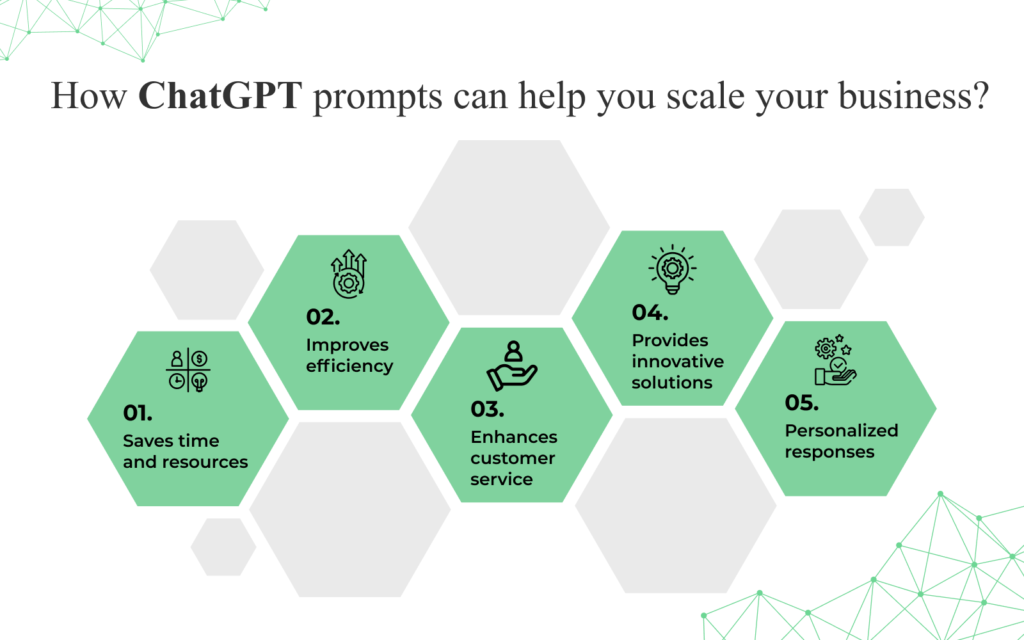The rise of ChatGPT has been nothing short of phenomenal. This cutting-edge technology has captured the attention of businesses worldwide with its ability to generate responses to various prompts. However, with the vast amount of information available, using the right ChatGPT prompts is essential to ensure maximum benefit.
In this blog, we’ll explore how ChatGPT has become an increasingly popular tool for businesses and the importance of using the right prompts to make the most of its capabilities. With over 300 carefully curated ChatGPT prompts across different areas of business, we’ll guide you through the process of optimizing your operations and strategies for maximum growth and profitability. So, whether you’re new to ChatGPT or a seasoned user, join us as we delve into the world of ChatGPT prompts and discover how to leverage its power for the benefit of your business.
How Does ChatGPT Work?
ChatGPT, short for “Generative Pre-trained Transformer 3”, is a state-of-the-art natural language processing (NLP) technology developed by OpenAI. It is a deep learning model that uses unsupervised learning to generate human-like responses to a wide range of prompts, including those related to business. The model is trained on a massive dataset of text from the internet, allowing it to understand and respond to natural language in a way that is almost indistinguishable from human communication.
ChatGPT uses a technique called Transformer, which allows it to process and understand text data more efficiently than previous NLP models. It can recognize context, tone, and other subtle nuances of language, making it an incredibly powerful tool for generating responses to a variety of prompts.
Furthermore, the “Pre-trained” part of its name means that the model has already been trained on a vast amount of text data, which makes it capable of understanding and responding to an even broader range of prompts.
In short, ChatGPT technology is a breakthrough in the field of natural language processing that allows businesses to communicate with their customers in a more efficient, human-like manner. With its ability to understand and generate natural language, it has become a popular tool for businesses looking to streamline their operations and enhance their customer service.
How ChatGPT Prompts Can Be A Game-Changer For Your Business?

ChatGPT prompts are essential for businesses looking to leverage the power of natural language processing and streamline their operations. Here are some reasons why:
- Saves time and resources: Generating ideas and solutions to complex business problems can be time-consuming and resource-intensive. With ChatGPT prompts, businesses can quickly generate responses to a wide range of prompts without spending hours brainstorming and researching.
- Improves efficiency: ChatGPT prompts provide businesses with quick and accurate responses, allowing them to make quick and informed decisions. This improves efficiency across different areas of business, from customer service to logistics and financial management.
- Enhances customer service: They can help businesses provide more personalized and efficient customer service. With ChatGPT, businesses can automate their customer service operations and respond to customer queries and concerns quickly and effectively.
- Provides innovative solutions: With ChatGPT, you can generate creative and innovative solutions to business problems that businesses may not have considered otherwise. This can help businesses stay ahead of their competition and grow more quickly.
- Customizable: ChatGPT prompts are highly customizable, allowing businesses to tailor their responses to their specific needs and objectives. This means businesses can use ChatGPT to generate responses for a wide range of prompts, including those related to sales and marketing, logistics, financial management, and more.
ChatGPT Prompts for Business Growth
Sales and Marketing
As businesses strive to reach more customers and increase their revenue, sales, and marketing strategies become critical components of their growth plans. ChatGPT prompts can help businesses in this area by generating responses to a variety of prompts related to sales and marketing.
Sales:
- How can I increase my sales revenue?
- What are the best sales strategies for B2B companies?
- What are the best sales strategies for B2C companies?
- How can I improve my sales team’s productivity?
- How can I create an effective sales funnel?
- What are the most effective sales techniques for closing deals with potential customers?
- How can I build strong relationships with my clients and keep them coming back?
- What are the best ways to upsell and cross-sell products or services to existing customers?
- How can I optimize my sales process to maximize efficiency and revenue?
Marketing:
- What are the best ways to promote my business on social media?
- How can I improve my email marketing campaigns?
- What are the best marketing strategies for a small budget?
- How can I use content marketing to increase my website traffic?
- How can I improve my website’s search engine optimization (SEO)?
- What are some effective ways to identify my target audience and create buyer personas?
- How can I create compelling and engaging marketing content that resonates with my audience?
- What are the best channels for reaching my target audience, and how can I optimize my marketing campaigns for each one?
- How can I measure the ROI of my marketing campaigns and make data-driven decisions about future strategy?
- What are some innovative ways to use social media for marketing?
- How can companies effectively use influencers to promote their brand?
- What are the most effective marketing strategies for a new product launch?
- How can businesses use content marketing to build brand awareness and generate leads?
- How can businesses effectively use data and analytics to improve their marketing campaigns?
- What are some of the biggest marketing trends of the year, and how can companies capitalize on them?
- How can businesses effectively market to Generation Z, and what are their preferences when it comes to marketing?
- How can companies use experiential marketing to create memorable brand experiences for customers?
Customer Engagement:
- How can I improve my customer engagement?
- What are the best ways to build customer loyalty?
- How can I personalize my customer interactions?
- What are the best customer retention strategies?
- What are some effective ways to communicate with customers across multiple channels to increase engagement?
- What are some creative ways to engage customers on social media?
- What are the most effective tactics for improving customer engagement during the sales process?
- How can I leverage customer feedback to improve engagement and retention?
- What are some ways to make my website more interactive and engaging for customers?
Branding:
- How can I create a strong brand identity?
- What are the best branding strategies for a new business?
- How can I differentiate my brand from my competitors?
- How can I use storytelling to enhance my brand?
- How can I develop a strong brand identity that reflects my company’s values and mission?
- What are the best ways to build brand awareness and recognition in my industry?
- How can I differentiate my brand from competitors and stand out in a crowded market?
- What are some effective branding strategies for building trust and credibility with customers?
- What are the key elements of a successful brand strategy?
- How can I create a consistent brand experience across all customer touchpoints?
Advertising:
- What are the best advertising channels for my business?
- How can I create effective advertising campaigns?
- What are the best advertising strategies for reaching a global audience?
- How can I measure the ROI of my advertising campaigns?
- How can I develop a consistent brand voice and messaging across all advertising channels?
- What are some best practices for designing effective and memorable advertisements?
- How can I measure the effectiveness of my advertising campaigns and adjust my strategy accordingly?
- What are some ethical considerations to keep in mind when advertising my brand?
- What are the latest trends in digital advertising?
Customer Service
Customer service is an integral part of any business, and it can make or break your company’s reputation. With the rise of social media and instant communication channels, customers expect prompt and efficient customer service. This is where ChatGPT prompts can come in handy. Here are some prompts that can help improve your customer service:
Automated Responses:
- How can I create an automated response system that is still personalized?
- What are the best practices for creating a chatbot to handle customer inquiries?
- How can I improve the accuracy of my automated responses?
- Can you suggest some examples of automated responses that have been successful in improving customer satisfaction?
- How can I ensure that my automated responses feel personalized and empathetic?
Problem Resolution:
- How can I effectively handle customer complaints?
- What are the best ways to de-escalate a tense situation?
- How can I improve the response time to customer inquiries?
- What are the best strategies for resolving complex customer issues?
- Can you suggest some techniques for handling angry or upset customers?
- How can I train my customer service team to handle complex issues and escalations?
- What are the most effective ways to resolve customer issues quickly?
- How can I leverage social media for customer service?
Customer Feedback:
- How can I gather feedback from customers to improve my customer service?
- What are the best ways to measure customer satisfaction?
- How can I use customer feedback to enhance the customer experience?
- What are some creative ways to collect customer feedback?
- How can I use customer feedback to improve my products or services?
- What are some metrics I should track to measure customer satisfaction and loyalty?
- What are the most common customer complaints, and how can I address them?
- How can I encourage customers to leave reviews and ratings for my business?
- What tools and software can I use to manage and analyze customer feedback data?
Personalization:
- How can I personalize the customer service experience?
- What are the best ways to make customers feel valued?
- How can I use customer data to create a more personalized experience?
- Can you suggest some ways to tailor my customer service approach to individual customers?
- What are some tools or technologies I can use to personalize my customer service interactions?
Multilingual Support:
- How can I offer multilingual customer support?
- What are the best ways to handle language barriers in customer service?
- How can I improve my multilingual support process?
- What are some strategies for hiring and training bilingual or multilingual customer service agents?
- How can I ensure that my multilingual support is effective and efficient without sacrificing quality or accuracy?
Content Creation
Content creation involves developing and sharing valuable, relevant, and consistent content to attract and retain a target audience. In today’s digital age, content creation is essential for businesses looking to establish a strong online presence and connect with customers.
Blogging:
- Can you suggest some topics for my business blog that will resonate with my target audience?
- What are some creative ways to generate blog post ideas?
- How can I make my blog posts more engaging and shareable?
- Can you help me optimize my blog content for SEO?
- What are some best practices for formatting and structuring blog posts?
- Can you suggest some guest blogging opportunities to help me expand my reach?
- How to write a compelling blog post headline that drives traffic?
- What are some effective ways to increase engagement on my blog?
- How to write an SEO-friendly blog post that ranks higher on search engines?
- How to find topics to blog about and keep your content fresh?
- How to format a blog post for maximum readability?
- How can you write blog posts that stand out from the competition?
- What are the best strategies for promoting your blog and driving traffic to it?
- How can you write blog posts that resonate with your target audience?
- What are some effective techniques for optimizing your blog posts for search engines?
Copywriting:
- Can you help me write persuasive product descriptions that will drive sales?
- How can I make my website copy more compelling and persuasive?
- Can you help me craft a compelling value proposition for my business?
- What are some best practices for writing effective call-to-actions?
- Can you help me optimize my copy for SEO?
- How to write a sales page that converts visitors into customers?
- What are some effective ways to write copy that grabs attention and keeps readers engaged?
- How to write a persuasive copy that convinces people to take action?
- How to use storytelling in your copy to create an emotional connection with your readers?
- What are the most important elements of a successful copywriting campaign?
- How can you craft headlines that grab your audience’s attention?
- What are some techniques for writing compelling product descriptions?
- How can you write a copy that effectively communicates your brand’s unique value proposition?
Email marketing:
- Can you suggest some email marketing strategies to help me reach my target audience?
- How can I write email subject lines that will grab my audience’s attention?
- Can you help me create a compelling email newsletter that will engage my subscribers?
- What are the best strategies for writing effective email marketing copy?
- What are some best practices for designing email templates?
- Can you help me A/B test my email campaigns to optimize their performance?
- What are some effective ways to increase your email open rates?
- How to write a compelling email copy that converts subscribers into customers?
- What are some best practices for email list segmentation and personalization?
- How to measure the success of your email campaigns and improve your ROI?
Operations and Logistics
Operations and logistics ensure the smooth functioning of day-to-day activities in a business. Inventory management, order processing, and shipping and delivery are three key aspects of operations and logistics that require careful attention.
Inventory management:
- How can I optimize my inventory levels to ensure that I always have the right amount of stock on hand?
- Can you suggest some inventory management software that will help me track my inventory more efficiently?
- How can I implement an inventory management system that integrates with my existing operations and logistics processes?
- What are some best practices for forecasting demand and managing inventory levels?
- What are the best inventory management practices for a growing business?
- How can I optimize my inventory levels to reduce costs and improve efficiency?
- What are some effective ways to track inventory across multiple locations?
- How can I automate my inventory management process using technology?
- What are the key performance indicators (KPIs) for measuring inventory performance?
- What are the risks and benefits of implementing just-in-time (JIT) inventory management?
- How can I ensure accurate inventory counts and prevent inventory shrinkage?
- What are the best ways to manage inventory across multiple locations or channels?
Order processing:
- What are the best practices for streamlining the order processing workflow?
- Can you suggest some tools or software that will help me streamline my order-processing workflow?
- How can I automate my order processing to ensure that orders are fulfilled quickly and accurately?
- What are some best practices for managing customer orders and ensuring timely delivery?
- How can I optimize my order processing system to reduce errors and increase efficiency?
- What are some effective ways to communicate with customers about their orders?
- How can I use data to analyze and optimize the order processing system?
- How can I streamline my order processing system to increase efficiency and reduce errors?
- What are some effective strategies for managing and prioritizing incoming orders to ensure timely fulfillment?
Shipping and delivery:
- Can you suggest some shipping carriers that offer reliable and cost-effective shipping services?
- How can I optimize my shipping and delivery processes to ensure the timely delivery of products to customers?
- What are some best practices for managing shipping and delivery costs?
- Can you help me track my shipments and ensure that they are delivered on time and in good condition?
- What are the best shipping and delivery options for my business?
- How can I reduce shipping costs while maintaining quality and speed?
- What are some effective ways to communicate shipping and delivery information to customers?
- How can I use technology to improve my shipping and delivery process?
ChatGPT Prompts for Financial Management
Budgeting
Budgeting is a critical aspect of financial management for any business, regardless of its size or industry. Creating budgets for different projects, tracking expenses, and identifying areas for cost savings are three key components of effective budgeting.
Creating budgets for different projects
- Can you suggest some tools or software that will help me create budgets for different projects more efficiently?
- How can I ensure that my project budgets are realistic and accurate?
- Can you help me estimate the costs associated with a new project and create a budget for it?
- What are some best practices for allocating funds across different projects and managing the overall budget?
- What are the most important factors to consider when creating a budget for a new project?
- How can I accurately estimate costs when creating a budget?
- What are the best practices for creating a budget for a business department?
- How can I ensure that my budget aligns with my business goals and objectives?
- How can I prioritize my budget to ensure that the most important expenses are covered first?
Tracking expenses
- How can I track my business expenses more efficiently and accurately?
- Can you suggest some expense-tracking software or tools that will help me streamline the process?
- What are some best practices for categorizing expenses and ensuring that they align with the budgeted amounts?
- Can you help me identify areas where I may be overspending and suggest ways to reduce expenses?
- What are the best ways to track expenses for a small business?
- How can I use technology to streamline my expense-tracking process?
- What are the most common mistakes to avoid when tracking business expenses?
- How can I categorize my expenses to gain a better understanding of where my money is going?
- How can I use expense tracking to identify areas for cost savings?
Identifying areas for cost savings
- How can I identify areas where I can cut costs and save money without compromising the quality of my products or services?
- Can you help me analyze my expenses and suggest areas where I can reduce costs?
- What are some best practices for negotiating with vendors and suppliers to reduce costs?
- How can I optimize my business processes to reduce expenses and increase efficiency?
- What are the most effective ways to identify areas for cost savings in a business?
- How can I evaluate my expenses to determine if they are necessary or if they can be cut?
- What are the most common areas where businesses can save money?
- How can I use data to identify areas for cost savings and make informed decisions?
Financial Analysis
Financial analysis is an important component of business planning and management. It involves evaluating the financial performance of a business and identifying areas for improvement.
Assessing financial performance
- Can you help me analyze my financial statements to assess my business’s financial performance?
- How can I determine if my business is financially healthy or if there are areas for improvement?
- What are some key financial metrics that I should be monitoring to assess my business’s financial performance?
- Can you suggest some financial analysis tools or software that will help me evaluate my business’s financial performance more efficiently?
- How can I evaluate the financial health of my business?
- What are the critical financial ratios I should be monitoring?
- What are some standard financial performance metrics, and how can I use them to make better business decisions?
- How can I interpret financial statements to understand my business’s performance?
Analyzing profitability
- Can you help me analyze my revenue and expenses to determine my business’s profitability?
- What are some key factors that impact profitability, and how can I improve them?
- Can you suggest some profitability analysis tools or software that will help me identify areas for improvement?
- How can I set profitability goals and track my progress toward achieving them?
- What are some ways to increase profitability?
- How can I calculate and analyze my profit margins?
- What are the differences between gross profit and net profit?
- How can I identify areas where I can cut costs and increase profitability?
Conducting cash flow analysis
- How can I assess my business’s cash inflows and outflows to determine its cash flow position?
- What are some key indicators of cash flow problems, and how can I address them?
- Can you help me forecast my cash flow to anticipate any potential cash flow issues?
- What are some cash flow management best practices that I should follow to ensure my business’s financial stability?
- How can I create a cash flow statement for my business?
- What are the components of a cash flow statement and what do they mean?
- How can I use cash flow analysis to improve my business’s financial performance?
- What are some strategies for improving cash flow and managing cash effectively?
Forecasting
Forecasting is an essential part of business planning that involves predicting future outcomes based on historical data and market trends. To create a compelling forecast, businesses must project future revenue, estimate expenses, and identify potential risks and opportunities. These ChatGPT prompts will help you do that:
Projecting future revenue
- How can I use historical data and market trends to predict future revenue for my business?
- What are some standard forecasting techniques that businesses use to project future revenue?
- Can you suggest any tools or software help me create accurate revenue projections?
- What key factors should I consider when projecting future revenue for my business?
- What factors affect our revenue growth, and how can we predict them?
- How can we improve our sales forecasting accuracy?
- What are the best practices for projecting revenue in a rapidly changing market?
Estimating expenses
- How can I use historical data and market trends to estimate future expenses for my business?
- What are some standard forecasting techniques that businesses use to estimate future expenses?
- Can you suggest any tools or software that can help me create accurate expense projections?
- What are some key factors that I should consider when estimating future expenses for my business?
- How can we accurately forecast our expenses for the next quarter/year?
- What are the main cost drivers in our business and how can we mitigate them?
- What are some strategies for reducing expenses without sacrificing quality or customer satisfaction?
- How can you accurately estimate expenses for a new project or initiative?
- What are some common expenses that are often overlooked in forecasting?
Identifying potential risks and opportunities
- How can I identify potential risks and opportunities that could impact my business?
- What are some common risk assessment techniques that businesses use to identify potential risks?
- Can you suggest any tools or software that can help me identify potential risks and opportunities?
- What are some key factors that I should consider when identifying potential risks and opportunities for my business?
- What are the potential risks to our business and how can we prepare for them?
- What are the emerging trends in our industry and how can we take advantage of them?
- How can we identify new markets or customer segments to target for growth?
- How can businesses identify potential risks that may impact their forecasting?
- What are some effective ways to mitigate financial risks?
- What are some opportunities that businesses should consider when forecasting?
ChatGPT Prompts for Business Strategy
Market Research
Market research involves collecting and analyzing data to better understand customers, competitors, and potential markets. By conducting market research, businesses can make informed decisions about product development, marketing strategies, and overall business growth.
Conducting customer surveys
- What are some effective ways to design and conduct customer surveys?
- Can you suggest any tools or software that can help me collect and analyze customer feedback?
- What types of questions should I ask in a customer survey to get the most useful feedback?
- How can I use customer survey data to improve my products or services?
- How can I get more customers to respond to my surveys?
- What are some common mistakes to avoid when conducting customer surveys?
Analyzing competitor data
- What are some effective ways to gather and analyze data about competitors?
- Can you suggest any tools or software that can help me analyze competitor data?
- What are some key metrics I should track when analyzing competitor data?
- How can I use competitor data to improve my own marketing and product development strategies?
- What are the best tools and techniques for analyzing competitor data?
- How can I identify my competitors’ strengths and weaknesses?
Identifying new markets
- What are some effective ways to identify potential new markets for my business?
- Can you suggest any tools or software that can help me research potential new markets?
- What are some key factors to consider when evaluating the potential of a new market?
- How can I develop products or services that appeal to a new market?
- How can I conduct market research to identify new opportunities?
- What are some strategies for entering a new market?
- How can I evaluate the potential profitability of a new market?
Business Planning
Business planning is a crucial aspect of running a successful business. It involves setting goals, developing strategies, and creating plans to achieve those goals. A well-crafted business plan can help a business stay on track, make informed decisions, and navigate challenges.
Creating business plans:
- What are the essential elements of a well-crafted business plan?
- Can you suggest any tools or software that can help me create a business plan?
- How do I create financial projections for my business plan?
- What should I include in a contingency plan for my business?
- How can I create a business plan that effectively communicates my vision and goals?
- What are the common mistakes to avoid when writing a business plan?
- How can I conduct a market analysis for my business plan?
- What financial projections should I include in my business plan?
Developing marketing strategies
- What are some effective ways to identify and target my ideal customers?
- Can you suggest any tools or software that can help me create effective marketing strategies?
- How can I measure the effectiveness of my marketing campaigns?
- What are some emerging trends in marketing that I should be aware of?
- What are the most effective marketing channels for my business?
- How can I identify and target my ideal customer demographic?
- What are the best practices for creating compelling marketing messages?
- How can I measure the effectiveness of my marketing campaigns?
- What are the emerging trends in digital marketing?
Setting business goals
- How do I set realistic and achievable goals for my business?
- Can you suggest any tools or software that can help me track my progress toward my goals?
- How often should I review and adjust my business goals?
- How can I motivate my team to work toward our business goals?
- How can I set specific, measurable, achievable, relevant, and time-bound (SMART) business goals?
- What are the best practices for prioritizing business goals?
- How can I align my business goals with my overall business strategy?
- What are the potential roadblocks to achieving my business goals, and how can I mitigate them?
Innovation
Innovation is crucial for businesses to stay competitive and meet the evolving needs of customers. It involves thinking outside the box and coming up with creative ideas to improve products, services, and processes. Successful innovation can lead to increased revenue, improved efficiency, and enhanced customer satisfaction.
Brainstorming new product ideas
- What are some techniques for generating creative product ideas?
- How can I involve my customers in the product ideation process?
- How can I evaluate the feasibility of new product ideas?
- What are some emerging trends in product design that I should be aware of?
- What are some innovative product ideas that would solve common problems for consumers?
- How can we use emerging technologies to create new products that will appeal to a wider audience?
- What are some unique features that we can incorporate into our products to differentiate them from competitors?
- How can we create products that are environmentally friendly and socially responsible?
- How can we incorporate customer feedback and preferences into our product development process?
Identifying opportunities for business growth
- How can I assess the potential of new markets or business opportunities?
- Can you suggest any tools or resources that can help me identify areas for business growth?
- How can I evaluate the risks and rewards of pursuing new business opportunities?
- What are some successful examples of businesses that have expanded into new markets?
- What are some untapped markets that we can explore for business growth?
- How can we expand our product or service offerings to reach new customers?
- Are there any partnerships or collaborations that we can pursue to grow our business?
- How can we leverage technology to streamline our operations and increase efficiency?
- What are some emerging trends in our industry that we can capitalize on for business growth?
Developing new business models
- How can I identify new ways of generating revenue for my business?
- Can you suggest any tools or resources that can help me develop new business models?
- What are some emerging trends in business models that I should be aware of?
- How can I test and validate new business models before fully implementing them?
- What are some alternative business models that we can explore to improve profitability and sustainability?
- How can we incorporate subscription-based models into our business?
- What are some innovative ways that we can monetize our existing products or services?
- How can we incorporate a social impact component into our business model?
- What are some ways that we can use data and analytics to optimize our business model and increase revenue?
ChatGPT technology has revolutionized the way businesses operate, communicate, and connect with their customers. With the right use of ChatGPT prompts, businesses can accelerate their growth and stay ahead of the competition. Whether it’s creating content, improving customer service, managing finances, or innovating new products, ChatGPT prompts can help businesses streamline their operations and achieve their goals more efficiently.
It’s essential to remember that while ChatGPT is a powerful tool, it still requires human input and oversight to ensure the quality and accuracy of its output. Therefore, businesses must train their staff to use ChatGPT effectively and ensure that the prompts align with their brand’s voice and messaging. With the right strategy and implementation, ChatGPT can be a game-changer for any business looking to stay competitive and thrive in today’s digital age.








